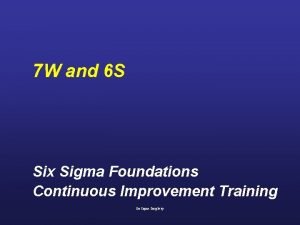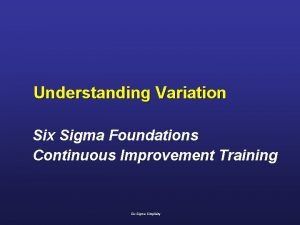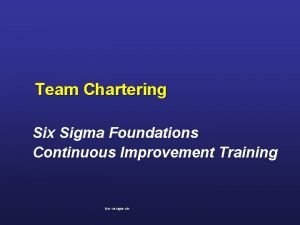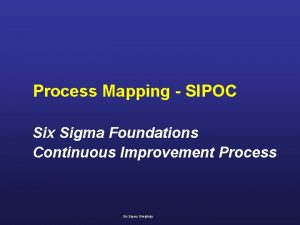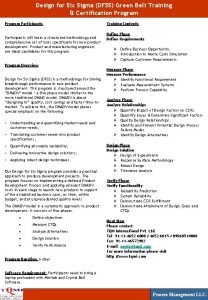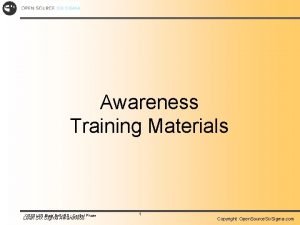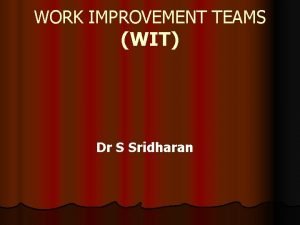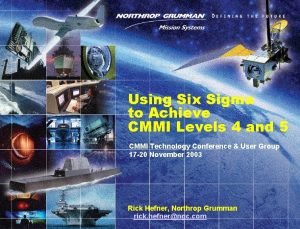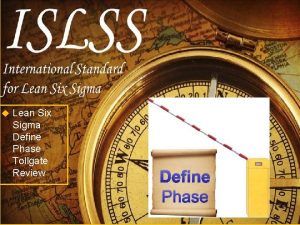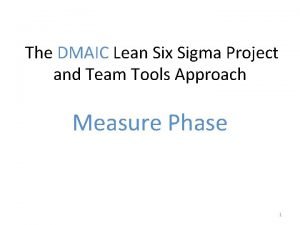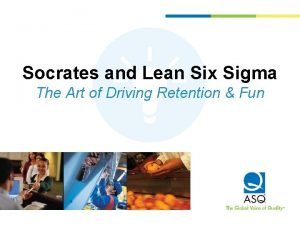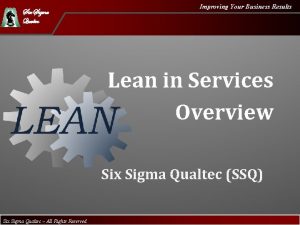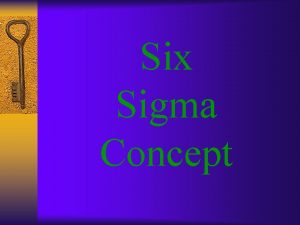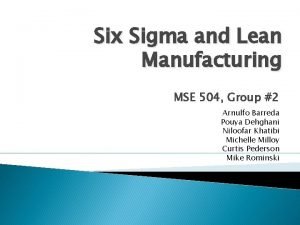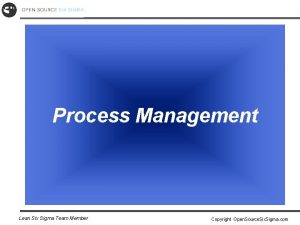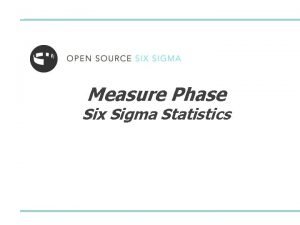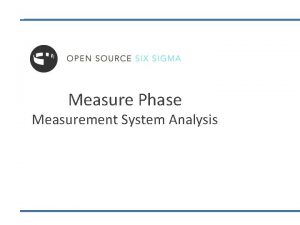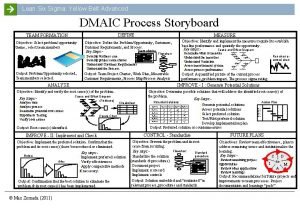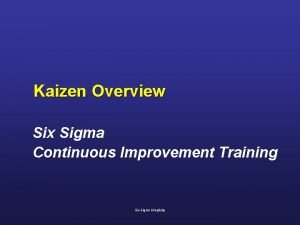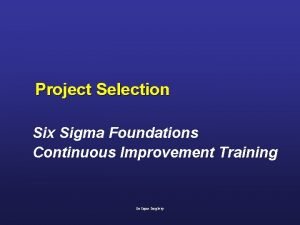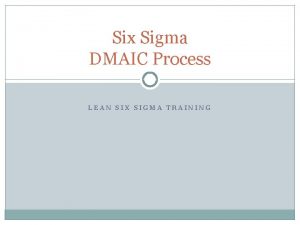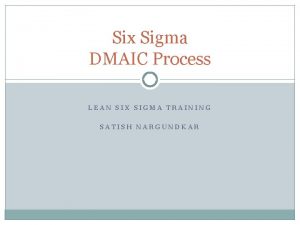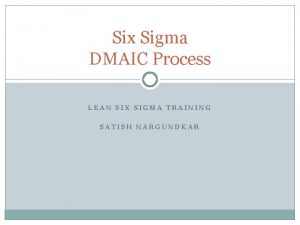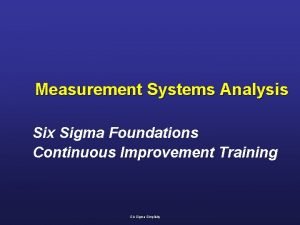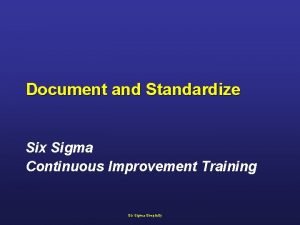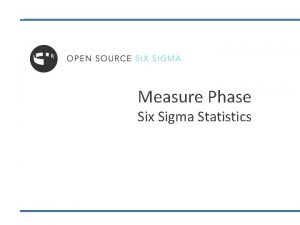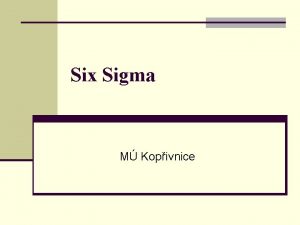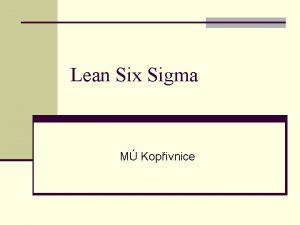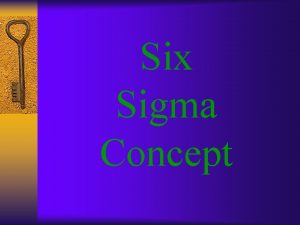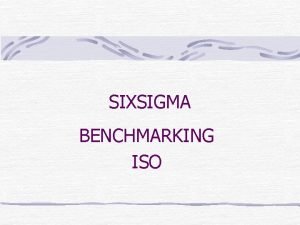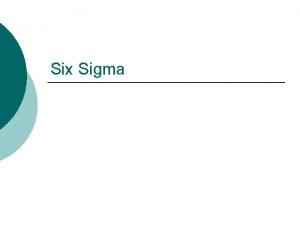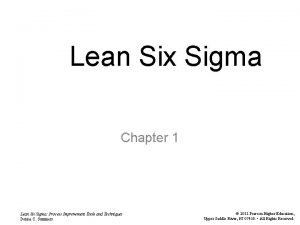Team Chartering Six Sigma Foundations Continuous Improvement Training



























- Slides: 27

Team Chartering Six Sigma Foundations Continuous Improvement Training free six sigma site

Key Learning Points Problem Statement/ Objective s Primary/ Secondary Metric s Cash/ Productivity (Benefits Model) s free six sigma site

Team chartering s The methodology of CI needs to be combined with the right people for real results s For process teams to achieve results that are meaningful, the priorities of the team members need to be aligned to the strategic goals of the project s Management needs to create a supportive environment and realign resources to priorities when needed free six sigma site

Project Charter A “passport” or governing document for a project team s Fixes the beginning and the end using a metric s Basic control over resources and resource conflicts s Demonstrates the need to change and areas of focus s Ensures that people are focussed on the businesses needs -examples free six sigma site

Project Charter – Why Do We Need It? s To guard against projects collapsing due to: s s s Inertia Passive resistance Redefinition Lack of buy in Lack of resource Overwhelming scope free six sigma site

Project Charter. Who Should Create It? s The Champion who has passion for the goal and who will fight for it. s who is skilled at delegating. s who has demonstrated success at involving others in their goals. s who has substantial organizational power and awareness. s NOTE: The project charter is created after the initial project identification form has been developed and this project has been selected as one to be started on by a Black Belt or Green Belt. free six sigma site

Project Charter Problem Statement Objective - example free six sigma site

Project Problem Statements and Objectives s The problem statement and objective should be S. M. A. R. T. s s s Specific---Focuses on a particular process, process characteristic or area Measurable---Can be measured to establish justification for project and validate improvement Attainable---Narrow scope to allow successful completion in a specified period of time Relevant---Directly tied to business and corporate imperatives Time Bound---Specifies a realistic period of time (usually 3 -6 months) free six sigma site

Problem Statement (Description) There are two purposes of the problem statement: s To focus the team on a process deficiency s To communicate the significance to others s The problem statement does NOT include any guess as to the cause of the deficiency, or what actions will be taken s A poor problem statement A good problem statement Warranty costs are too high due to product A and will be reduced by analyzing first and second level pareto charts. From Jan – Jun 20 xx, the average warranty costs are 5% of sales with a range of 2% to 12%, resulting in a loss of $5 M. free six sigma site

Problem Statement What if no data exists? Preliminary Problem Statement: Warranty Returns During X length of time, the “Primary Metric” (the issue) was X, which resulted in a loss of $X. Specific data will be defined via data collection and analysis. Data free six sigma site Specific data will have to be collected to justify giving the project priority.

Problem Statement After Data Collection: From 1994 to 1998, Product returns are 5% of sales with a range of 2% to 12%, resulting in a profit impact of $5 M. Returns by Product Group free six sigma site # of Returns for Product A

Objective The objective states the goal of the project. It must: s Address the issue described in the problem statement s Quantify the expected performance improvement s Identify the expected timing s Like the problem statement, the objective does not state the cause of the deficiency or what actions will be taken s A poor objective A good objective Reduce Warranty costs by implementing individual performance measures and objectives. Reduce Warranty costs from 5% to 2. 5% of sales by year end 20 xx, which will result in a savings of $xxx. free six sigma site

Primary Metric s The primary metric is the yardstick that will be used to measure your success. It must: Be consistent with the problem statement and objective s Include 3 series of data, plotted as a function of time: s baseline performance (average over the past 12 months, if possible) s actual performance s Objective / goal s free six sigma site

Primary Metric - sample free six sigma site

Secondary Metric s The secondary metric is the conscience that will “keep you honest” Tracks potential negative consequences s More than one may be required s Examples: cycle time, cost, customer satisfaction s free six sigma site

Sample Secondary Metric free six sigma site

Sample Secondary Metrics s Primary Metric: Lead Time s s Potential Secondary Metric: Quality, OT Costs, Costs Primary Metric: Quality (Defects) s Potential Secondary Metric: Lead Time, OT Costs, Costs free six sigma site

Project Charter This figure comes from the Company Benefits model -examplefree six sigma site

Cash and Productivity Savings Even in the preliminary stages of selecting a project, calculating the projected benefits is critical. s Savings are broken into two categories: Cash Savings: Those savings which directly goes to the bottom line for the business (hard savings). Productivity Savings: The total measurable savings generated from the project (hard and soft savings combined). s To help estimate project savings, use a “financial model” spreadsheet free six sigma site

Financial Model Cash and Productivity Savings Sheet example Refer to the Excel Spreadsheet for complete details and examples on how to fill out this form. One must be filled out for every project. free six sigma site

Team members roles 4 Contribute process expertise 4 Communicate on the team change with other co-workers not 4 Collect data 4 Accept and complete all assigned action items 4 Implement 4 Attend 4 Stay improvements and participate in all meetings motivated free six sigma site

Project Charter : Example Problem Statement – From Jan to March, 20 xx, 23 orders per day were invoiced, which resulted in a loss of $20, 000 a year. s Objective - To increase the number of invoiced orders from 23 to 45 invoices per day for at least 10 days in succession by the end of the month, which will result in a savings of $20, 000. s Benefits – The $20, 000 is the cost of additional staff. s free six sigma site Primary metric s Resources up to s s s 20 hours of Black Belt time Goal of systems 20 hours programmer $1000 Expenses 100 hours from Accounts personnel Milestones Baseline s Q & M by day 3 s s A & I by day 15 C by day 20

Project Charter : Example Problem Statement – From Jan to March, 20 xx, 23 orders per day were invoiced, which resulted in a loss of $20, 000 a year. s Objective - To increase the number of invoiced orders from 23 to 45 invoices per day for at least 10 days in succession by the end of the month, which will result in a savings of $20, 000. s Benefits – The $20, 000 is the cost of additional staff. Planning s free six sigma site s Resources up to s s s 20 hours of Black Belt time 20 hours of systems programmer $1000 Expenses 100 hours from Accounts personnel Milestones s D & M by day 3 A & I by day 15 C by day 20

Project Charter : Example s s s s Budget 20 XX $ Key milestones Define : Feb 01 Measure : April 02 Analyze : May 03 Improve : June 04 Control : July 05 Champion I. M. de Boss Team Members Alex Dollar : GB/GB Bernard Euro : Controller Charles Sterling: A/R David Yen : A/R free six sigma site Secondary metric

Project Charter - Leadership’s Role s Provide Strategic Goals s Check that your strategic goals (QMS) and local projects are linked s Check that local goals, resources and benefits are related s Appraise your managers on their ability to Champion change and to provide consistency free six sigma site

Project Charter - Champion’s Role s Be more explicit about what you want than how to achieve it s Push, Push! Review progress using Roadmap and Charter Metrics free six sigma site Demand resources and results s Demonstrate passion. Put the Charter on your wall. Make time in your calendar s Enrol others. Help the team achieve buy in. Use your Elevator speech. Get a flip chart in your office. s Find out how the project is perceived. s

Team Chartering Six Sigma Foundations Continuous Improvement Training free six sigma site
 Lean six sigma foundations
Lean six sigma foundations Six sigma foundations
Six sigma foundations Six sigma foundations
Six sigma foundations Lean six sigma foundations download
Lean six sigma foundations download Tramp and liner shipping
Tramp and liner shipping Texas 4-h chartering
Texas 4-h chartering Ship chartering courses
Ship chartering courses Dfss green belt
Dfss green belt Open source six sigma training material
Open source six sigma training material Vcom white coat ceremony
Vcom white coat ceremony Vcom mission statement
Vcom mission statement Work improvement teams singapore
Work improvement teams singapore Present continuous definition
Present continuous definition Present simple present continuous past simple
Present simple present continuous past simple Cmmi six sigma
Cmmi six sigma Microsoft six sigma
Microsoft six sigma Voice of the customer six sigma
Voice of the customer six sigma Statapult exercise
Statapult exercise Who is this
Who is this Six sigma qualtec
Six sigma qualtec Six sigma forum
Six sigma forum Six sigma kpov
Six sigma kpov Mse six sigma
Mse six sigma Six sigma storyboard
Six sigma storyboard Six sigma belts hierarchy
Six sigma belts hierarchy Statistics symbols cheat sheet
Statistics symbols cheat sheet How is msa calculated
How is msa calculated Dmaic storyboard
Dmaic storyboard
